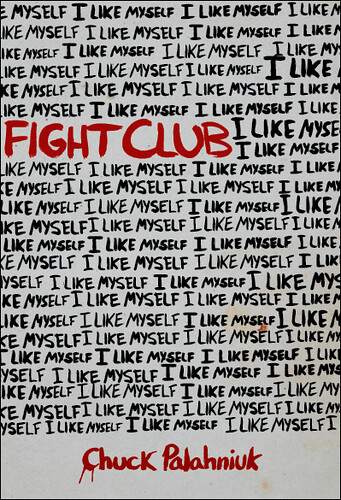"The truth is, being ugly isn't the thrill you'd think, but it can be an opportunity for something better than I ever imagined." (Palahniuk 288)
Invisible Monsters was originally the first book written by Chuck Palahniuk, but became the second published due to agencies believing it too disturbing for publishing.
So begins Chuck Palahniuk's inspiringly original, intoxicating new novel about drug use, plastic surgery, and horribly disfigured fashion models.- Jonathan Shipley, January Magazine.
‘The fashion photographer inside my head yells:
Give me pity.
Flash.
Give me another chance.
Flash. (Palahniuk 104)'
Jump to me finding it in Half Price Books for 6 bucks.
Give me enthusiasm.
Flash.
Give me love.
Flash.
Now jump to a basic rendition of the plot that gives nothing major away yet still captures that fact that it’s life changing.
Flash.
The book starts off at the end, as like most of Paluhniuks books, At Evie Cottrells, Shannon’s once best friend, wedding where Brandy Alexander is shot and killed and the gosh house is on fire. Then it jumps to her childhood with the brother, she hated. The brother who was kicked out for being gay then presumed a martyr after a mysterious caller claimed he died of AIDs. Shannon McFarland was top model until a .30 caliber shotgun shot off her face who becomes a drug thief with Manus Kelley, her ex-fiancé, and Brandy Alexander, her best friend; Both characters as we learn are closer to each other and Shannon than we think. The three head out on a across country trip and pretend to be interested in purchasing nice homes on the market when instead they steal drugs from the current owners then sell them in night clubs in Seattle.
Give me a review.
Flash.
‘Chuck Palahniuk is on the verge of something big.’ Writes Jonathan Shipley in his review of the book as he writes that the book is not for everyone and may give young people nightmares. Which in this case is presumably the truth. The characters are complex yet real, they have their problems like everyone else which intern makes more real and human then anything else I have ever read.
Jump back to the plot where she describes her accidental, yet not accidental, traffic accident where she gets her jaw shot off and she drives herself to the hospital. At the hospital she meets Brandy Alexander in speech therapy where Brandy tells her that best way to get over your past is to reinvent yourself, give yourself a new name, a new background in other words a totally new existence.
While in the hospital her fiancé breaks up with her and she finds out her best friend, Evie, has been sleeping with him and wearing her clothes.
Jump to her describing what it’s like to do a photo shoot in a slaughterhouse.
Shannon goes on to describe how she hated her brother. She hated him because he got al the attention from her family, he was the one who got blown up from a hairspray can that was in the trash, he got kicked out, and then he ‘died’ of AIDs. After his ‘death’ he was more loved than ever and ever even treated like a martyr and they never once asked her how she was.
‘Give me anger.
Flash.’ (Palahniuk 158)
‘Give me needy emotional whining bullshit.
Flash.’ (Palahniuk 224)
What happens in the story is sometimes difficult to explain with out giving something vital away. In order to effectively read it you have to have an open mind and remember every detail so that once the ending is reached you realize how everything comes together, even the things that seemed trite and odd.
‘This story is Thelma and Louise squared and to the second power. It's a buddies-who-hate-each-other bonding adventure. It's a story of mutilation, stolen Percodan, real estate charades, tacky fashion, and a wedding in a burning house. It's sibling rivalry and boob jobs. Here's the thing, if I had known this book was a strange, violent comedy, I NEVER would have bought it, even for 25 cents. BOY, am I glad I did! After I read this book, I went out and bought some of Palahniuk's other books for FULL PRICE.’ - Dehands
Now jump to me writing a blog about it.
__________________________________
Work Cited
Invisible Monster. Photograph. Illiterary. Web. .
Palahniuk, Chuck. "Chapter31 Page 288." Print
Shipley, Jonathan. "The Monster Club." January Magazine. Web. .
Palahniuk, Chuck. "Chapter 8 Page 104." Print
Palahniuk, Chuck. "Chapter 15 Page 158." Print.
Palahniuk, Chuck. "Chapter 22 Page 224." Print.
Dehands. "Invisible Monsters." Rev. of Invisible Monsters. Web log post. Shvoong. Web. .






